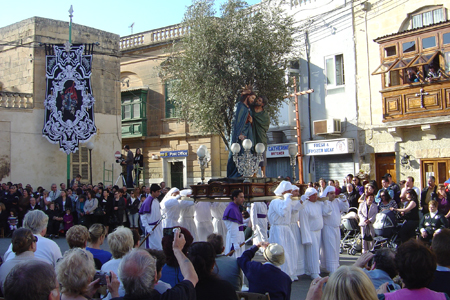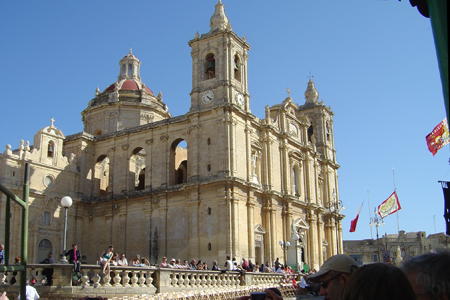| |
 |
 |
 |
| Comment on this report, or find other reports. |
 |
| Our Mystery Worshippers are volunteers who warm church pews for us around the world. If you'd like to become a Mystery Worshipper, start here. |
 |
| Find out how to reproduce this report in your church magazine or website. |
|
|
| 1940: The Good
Friday Procession, St Catherine of Alexandria, Zejtun, Malta |
 |
 |
 |
Mystery Worshipper:
Mark Wuntoo.
The church:
Good Friday Procession, Zejtun, Malta.
Denomination:
Roman Catholic, Archdiocese of Malta.
The building:
The tradition of the Good Friday procession is carried on under
the auspices of the parish of St
Catherine of Alexandria, Virgin and Martyr. The parish traces
its history back to the 1430s, although the present church was
built over a period of 28 years around the turn of the 18th
century after a design by Lorenzo Gafà, a Maltese baroque
architect responsible for dozens of churches, cathedrals and
bishop's palaces. The majestic baroque edifice, built in Maltese
stone, is graced by an attractive dome, Doric and Ionic pilasters,
and massive cornices all round. A clock informs us of the time,
whilst a second clock shows a false hour to confuse the devil
about the times of the mass.
The church:
If the parishioners are anything like the other church congregations
we observed at worship in Malta, they are zealous and totally
committed to the Roman Catholic faith. The church website appears
to indicate an emphasis on traditional church activities such
as liturgy, catechesis, etc., with limited involvement in social
service and the environment.
The neighbourhood:
Zejtun is a quiet town in a beautiful site on top of a hill
in the south of Malta, with the Maltese capital city of Valletta
to the north and the fishing village of Marsaxlokk to the south.
With a population 12,000, it is set amidst a fertile landscape
that produces a wide variety of fruit and vegetables. The town
takes its name from the Sicilian Arabic word for olive, referring
to the olive trees that grow in abundance in the area. Narrow
streets, many houses with religious icons in niches in their
walls, a palace from the days of the Grand Masters, and the
remains of a Roman villa still being excavated, as well as St
Catherine's church itself and the smaller and much older church
of St Gregory, make Zejtun a must-visit Maltese tourist attraction.
The cast:
About 800 people of all ages led the procession. None were named,
but I did observe the parish priest, the Revd Eric Overend,
running around making sure everything was proceeding smoothly.
The date & time:
Good Friday, 2 April 2010.
What was the name of the service?
Good Friday Procession.
How full was the building?
Thousands of people lined the streets of the town, some sitting
but most standing for the duration of the procession. Tour operators
in mini-buses arriving from all over the island dropped their
passengers a little way out of the centre of town. Seats were
provided for us at a strategic spot near to the church. Around
the vicinity of the church, the crowd spilled from the pavements
onto the road.
Did anyone welcome you
personally?
A personal welcome seemed inappropriate – we all were
there to appreciate the drama of Good Friday portrayed in live
pageant. Maltese people, like island folk all over the world,
may hesitate to speak to visitors until they themselves begin
a conversation, but they are nevertheless very welcoming. We
had interesting conversations with a number of people, sharing
ideas about Easter, the cost of the forthcoming visit of the
Pope, and the proposed introduction of bendy (articulated or
accordion) buses on the Maltese roads.
Was your pew comfortable?
It was one of the slatted wooden chairs provided by the local
band club to the tour operator, not very comfortable. But everybody
spent time on their feet as the pageant passed by.
How would you describe
the pre-service atmosphere?
18 degrees Celsius (64 degrees Fahrenheit) under a cloudless
sky. The atmosphere was expectant – we could feel the sense
of reverent waiting for the visual telling of the story. I expect
that most people would have been to mass earlier in the day.
What were the exact opening
words of the service?
There were no spoken words at any point in the drama. A number
of church officials dressed in purple and white led the procession,
which included brass bands, each playing sombre funeral marches.
What books did the congregation use during the
service?
None were necessary – the whole event was more of a visual
spectacle than a service and required no verbal involvement.
What musical instruments were played?
The two Zejtun bands, each with about 100 members, played the
whole range of brass and wind instruments. Roman soldiers with
snare drums and bugle fanfares added to the occasion.

Did anything distract you?
There was a constant strange noise like the hum of an electrical
shortage; we later discovered that this was the playing of snare
drums outside the church entrance. It seemed out of place and
unnecessary, although it probably had a reasonable explanation.
Also, there was a moment involving three elderly nuns and where
they should sit that I found mildly distracting – see below.
Was the worship stiff-upper-lip,
happy clappy, or what?
It was solemn and intense. We watched with quiet reverence.
The procession embodied a recounting of the Easter story placed
in the wider context of both Old and New Testaments. The story-telling
commenced at the doors of the church and proceeded through the
streets of Zejtun, returning much later to the church. Twelve
life-size statues placed on large wooden plinths were each carried
by eight white-robed men assisted by four other men who helped
to steady the structure on its journey. The whole moved with
a swinging motion as the bearers kept in step. The statues included
representations of Christ in the Garden of Gethsemane, the scourging
of Christ, Christ carrying the cross, Christ on the cross with
the women watching, the dead Christ leaning on the breast of
Mary with Joseph and Nicodemus alongside, and the resurrected
Christ. These were interspersed with children and adults who
portrayed figures such as the high priest, Pontius Pilate, Roman
soldiers, and passers-by at the cross. John the Baptist's head
was carried on a dish. Pots of oil, bunches of grapes, a live
sheep, and a stuffed cockerel added to the drama. The procession
made frequent stops that allowed people to reflect on the scenes
and to listen to the bands.
Exactly how long was the
sermon?
Given that it was a telling of the biblical story surrounding
the events of Good Friday, it could rightfully be argued that
the whole two and one-half hours was a sermon. It seemed not
a moment too long!
On a scale of 1-10, how good was the preacher?
10 – The 800 preachers, aged from very young children to
bearded old men, gave it their all and deserve the highest praise
(which I am sure they did not seek) for their serious portrayal
of characters. The use of costumes and scenic props added to
the majesty of it all.
Which part of the service
was like being in heaven?
It was strangely down to earth, probably because it involved
so many lay people, yet it was truly uplifting to a higher plane.
The procession was presented as a whole and would not have been
complete without every scene.
And which part was like being in... er... the other place?
The tendency to what seemed to me to be superstitious dependence
was sad to observe. I do, however, recognise that such activities
bring inspiration, challenge and comfort to many, not only in
participating as an actor but also through observation and identification
with the story and its tellers.
What happened when you hung around after the service looking lost?
The electricity went off island-wide – but not by design. That's
another story, though. There was no time to hang around.
How would you describe the after-service
coffee?
Ftira (large bread rings), figolla (almond-filled shortcake
biscuits in various shapes and sizes), and various fizzy drinks
and juices were available at a number of stalls along the route
of the procession.
How would you feel about making this church your regular (where 10 = ecstatic, 0 = terminal)?
1 – As colourful and passionate as it all was, this is
nevertheless not my brand of encounter with the divine.
Did the service make you feel glad to be a
Christian?
Well, I'm not a Christian, but if I were, I think I might have
been overwhelmed by the rich pageantry. That said, it was a
delight to be present – and it did get to me!
What one thing will you remember about all this in seven days' time?
The three elderly nuns on the street corner who (although I
did not understand what they were saying) seemed to be arguing
over which of them should not sit in the one available
chair. |
|
|
 |
 |
 |
| We rely on voluntary donations to stay online. If you're a regular visitor to Ship of Fools, please consider supporting us. |
 |
 |
 |
| The Mystery Pilgrim |
 |
| One of our most seasoned reporters makes the Camino pilgrimage to Santiago de Compostela in Spain. Read here. |
 |
 |
 |
| London churches |
 |
| Read reports from 70 London churches, visited by a small army of Mystery Worshippers on one single Sunday. Read here. |
| |
|
|
|
|


